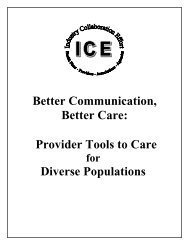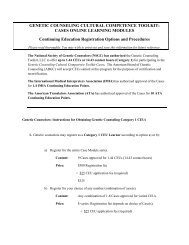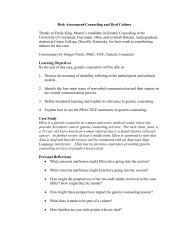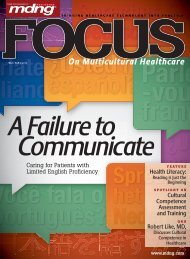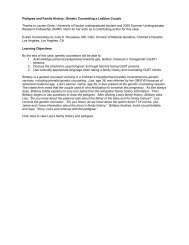Advanced Effective Communication, Cultural Competence, and ...
Advanced Effective Communication, Cultural Competence, and ...
Advanced Effective Communication, Cultural Competence, and ...
Create successful ePaper yourself
Turn your PDF publications into a flip-book with our unique Google optimized e-Paper software.
A Roadmap for Hospitals<br />
Appendix C: New Joint Commission Requirements<br />
New Joint Commission PC Requirements<br />
PC.02.01.21 The hospital effectively communicates<br />
with patients when providing care, treatment, <strong>and</strong><br />
services.<br />
Note: This st<strong>and</strong>ard will not affect the accreditation decision at<br />
this time.<br />
Rationale for PC.02.01.21<br />
This st<strong>and</strong>ard emphasizes the importance of effective<br />
communication between patients <strong>and</strong> their providers of care,<br />
treatment, <strong>and</strong> services. <strong>Effective</strong> patient-provider communication<br />
is necessary for patient safety. Research shows that<br />
patients with communication problems are at an increased risk<br />
of experiencing preventable adverse events, * <strong>and</strong> that patients<br />
with limited English proficiency are more likely to experience<br />
adverse events than English speaking patients. † ‡<br />
Identifying the patient’s oral <strong>and</strong> written communication needs is<br />
an essential step in determining how to facilitate the exchange<br />
of information with the patient during the care process. Patients<br />
may have hearing or visual needs, speak or read a language<br />
other than English, experience difficulty underst<strong>and</strong>ing health<br />
information, or be unable to speak due to their medical condition<br />
or treatment. Additionally, some communication needs may<br />
change during the course of care. Once the patient’s<br />
communication needs are identified, the hospital can determine<br />
the best way to promote two-way communication between the<br />
patient <strong>and</strong> his or her providers in a manner that meets the<br />
patient’s needs. This st<strong>and</strong>ard complements RI.01.01.01, EP 5<br />
(patient right to <strong>and</strong> need for effective communication);<br />
RI.01.01.03, EP 2 (provision of language interpreting <strong>and</strong><br />
translation services); <strong>and</strong> RI.01.01.03, EP 3 (meeting needs of<br />
patients with vision, speech, hearing, or cognitive impairments).<br />
EP 1<br />
EP 2<br />
The hospital identifies the patient’s oral <strong>and</strong> written<br />
communication needs, including the patient’s preferred<br />
language for discussing health care. (See also<br />
RC.02.01.01, EP 1)<br />
Note 1: Examples of communication needs include the<br />
need for personal devices such as hearing aids or<br />
glasses, language interpreters, communication boards,<br />
<strong>and</strong> translated or plain language materials.<br />
Note 2: This element of performance will not affect the<br />
accreditation decision at this time.<br />
The hospital communicates with the patient during the<br />
provision of care, treatment, <strong>and</strong> services in a manner<br />
that meets the patient’s oral <strong>and</strong> written communication<br />
needs. (See also RI.01.01.03, EPs 1-3)<br />
Note: This element of performance will not affect the<br />
accreditation decision at this time.<br />
* Bartlett G. et al: Impact of patient communication problems on the risk of preventable adverse events in acute care settings. CMAJ 178(12):1555-1562,<br />
Jun. 3, 2008.<br />
† Divi C, Koss R.G., Schmaltz S.P., Loeb J.M.: Language proficiency <strong>and</strong> adverse events in U.S. hospitals: A pilot study. Int J Qual Health Care 19(2):60-67,<br />
Apr. 2007.<br />
‡ Cohen A.L., et al: Are language barriers associated with serious medical events in hospitalized pediatric patients? Pediatrics 116(3):575-9, Sep. 2005.<br />
safety [4,5]. PC.02.01.21, EP 1, complements existing requirement<br />
RI.01.01.01, EP 5, which focuses on the patient’s right<br />
to <strong>and</strong> need for effective communication. The new requirement<br />
emphasizes the need to promote two-way communication<br />
between the patient <strong>and</strong> the provider. Identifying a<br />
patient’s communication need is an essential step in determining<br />
how to best facilitate the exchange of information with<br />
the patient during the care process.<br />
Note 1 at PC.02.01.21, EP 1, provides several examples of communication<br />
needs to raise awareness that needs range from the<br />
obvious to the subtle. EP 1 uses the phrase “preferred language<br />
for discussing health care.” While some patients may be able to<br />
converse at a basic level in English, they may require an interpreter<br />
during complex medical discussions to fully underst<strong>and</strong>,<br />
especially during stressful conversations. EP 2 is not intended to<br />
require that every written material be translated into every patient<br />
language, but to make sure that the hospital takes into consideration<br />
a specific need a patient has for written materials. For<br />
example, if a patient only reads in Russian, <strong>and</strong> patient education<br />
materials are not available in that language, other means of<br />
supporting patient education should take place. Or, if a patient<br />
uses glasses to read, staff must make sure that the patient’s glasses<br />
are accessible when using written materials during patient education.<br />
(For guidance on determining which <strong>and</strong> how many languages<br />
to translate written materials, see Appendix D: Laws <strong>and</strong><br />
Regulations, page 65.)<br />
Self-Assessment Guidelines<br />
• Observe how services are provided to verify that patient’s<br />
oral <strong>and</strong> written communication needs are identified <strong>and</strong><br />
addressed during the course of care. For example, is the<br />
nurse call button accessible to the patient? Does a staff<br />
member respond in person, instead of using the intercom,<br />
59



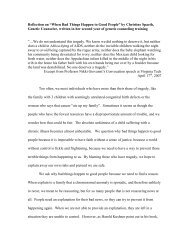
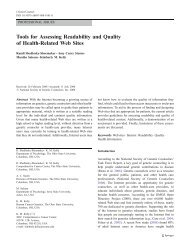

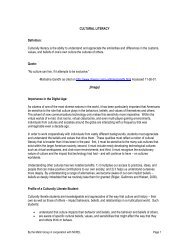
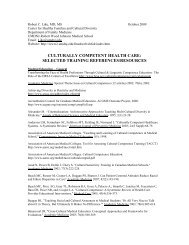

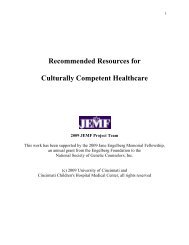

![Breaking Bad News PPT[1] - Genetic Counseling Cultural ...](https://img.yumpu.com/35003134/1/190x146/breaking-bad-news-ppt1-genetic-counseling-cultural-.jpg?quality=85)
